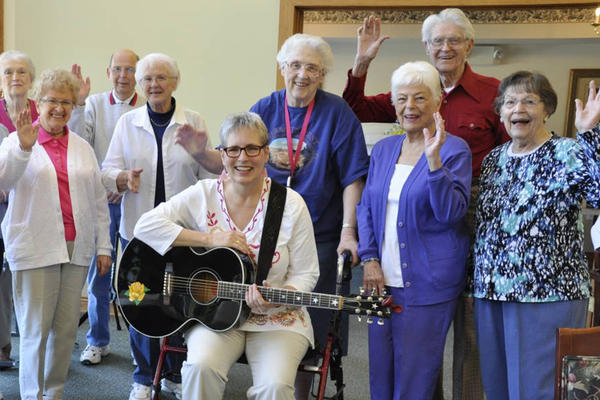Activities
Laughing During the Dementia Journey: A Map to Increased Health and Happiness
“I feel so much better after all this laughing,” our friend told us. “My brain fog has lifted. I feel myself again.” Our friend has been struggling with memory issues and a dimness in her thinking. We had a wonderful time practicing laughing exercises with her. The more we laughed together, the easier and more spontaneous our laughter flowed. Laughing during the dementia journey left us all feeling healthier, happier, and more energized.
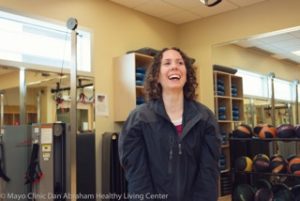 As I develop my own laughter practice, I wanted to know more from someone who’s really integrated laughing into her life. I asked Amy Kuth to share her insights. Amy is a Health & Wellness Coach at Mayo Clinic’s Dan Abraham Healthy Living Center in Rochester, MN. She has been practicing laughter for several years and has created an on-going Laughter Club for Mayo employees. She recently completed a five-day teacher training course. Here is my Q and A with Amy.
As I develop my own laughter practice, I wanted to know more from someone who’s really integrated laughing into her life. I asked Amy Kuth to share her insights. Amy is a Health & Wellness Coach at Mayo Clinic’s Dan Abraham Healthy Living Center in Rochester, MN. She has been practicing laughter for several years and has created an on-going Laughter Club for Mayo employees. She recently completed a five-day teacher training course. Here is my Q and A with Amy.
What benefits have you seen from your laughter yoga practice?
Laughter yoga helped me discover my playful side again after it had gotten buried under life pressures and self-criticism. Since I started leading laughter yoga and having a regular laughter practice I have become more confident, creative, and playful at home and in my workplace. Laughter brings me into the present moment, creates harmony in my mind/body/spirit, connects me to those that I am laughing with, and always puts me in a good mood! I also set a daily intention to bring extra laughter into my specific work unit, outside of the laughter yoga sessions. Doing this elevates our mood, encourages playfulness, increases creativity, and brings us closer together as a team.
How has your team, working in Employee Health at Mayo, benefitted from the extra laughter? 
In the weekly Mayo Clinic Laughter Club, we do a one word check-in at the end of our laughter yoga sessions. Words include: relaxed, energized, calm, happy, stress-free, , warm, peaceful, and grateful. These sessions are a great way for participants to take a break from work and other responsibilities, and to refresh and reset. The benefits of these sessions are then carried into the rest of their day.
What are some quick ways to add a splash of laughter into your day?
Plenty of haha’s a day keep the doctor away!
Here are a few ideas for adding a quick splash of laughter to your day:
- Surround yourself with positive people and things.
- Laugh in your car while you are driving to work.
- Affirm yourself with a smile and laughter while looking in the mirror.
- Smile at someone else and see what happens.
- Attend a laughter yoga club.
- Add humor to your day through media, fun activities, and social connections.
- Have a laughter buddy.
- Laugh into your cell phone, even if nobody is on the other line.
- Join a live laughter party on the phone.
- Set a timer for one-minute and just laugh until the time is up.
Why is adding laughter to our day important?
In a typical day, laughter is usually sporadic and short lived. In order to gain the most benefit from laughter it needs to be long and deep, stimulating the diaphragm. Intentionally adding laughter to our day helps us receive these benefits. The benefits of laughter can be summarized simply by remembering the 5 H’s, which I learned in my teacher training.
Happy : Laughter makes us happier by elevating our mood and attitude. We do better in life with a improved mood and attitude.
Healthy: Laughter improves our immune system and physical health. When we are healthier we can do more.
Harmony: Laughter oxygenates and creates harmony in our body and brain. What we do is more effective and efficient.
Heartfelt: Laughter enriches our relationships and creates connection with others and with our self. Laughter is a universal language that breaks down barriers and causes judgment and self-criticism to fade.
Hopeful: Laughter increases resilience. We bounce back better from adversity.
For more information about Laughter Yoga and about laughing during the dementia journey, please visit: www.laughteryoga.org or http://robertrivest.com
Deborah Shouse is the author of Connecting in the Land of Dementia: Creative Activities to Explore Together and Love in the Land of Dementia: Finding Hope in the Caregiver’s Journey.
Laughing Increases Happiness and Health: Enriching the Dementia Journey
Ever since I interviewed Dr. Madan Kataria, the founder of Laughter Yoga, I’ve wanted to learn more and laugh more. That’s because laughing increases health and happiness.
There are no Downward Facing Dogs, Warriors, or other traditional yoga postures in the laughter practice. Instead the focus is on gentle breathing exercises, easy movements, and, of course laughing. Dr. Kataria researched the science of laughter and learned that the body does not differentiate between intentional and real hilarity.
Dr. Kataria believes that laughing is a skill anyone can master and laughter yoga is ideal for people living with dementia. He says: “Laughter Yoga is an aerobic workout that helps uplift your mood within minutes by releasing endorphins from your brain cells. You often remain energized, relaxed, and in good spirits throughout the day. Laughter also makes your immune system stronger and lowers your blood pressure. Plus laughing with others builds a social bond and reduces feelings of isolation.”
 Several weeks ago, Ron and I journeyed to Ferryville, Wisconsin, to study laughter with the esteemed Master Trainer, Robert Rivest. We are now Certified Laughter Yoga Leaders. Delightfully, laughing increases happiness and health and over the next months, we’d love to share some of the benefits and joys of intentional laughing with you.
Several weeks ago, Ron and I journeyed to Ferryville, Wisconsin, to study laughter with the esteemed Master Trainer, Robert Rivest. We are now Certified Laughter Yoga Leaders. Delightfully, laughing increases happiness and health and over the next months, we’d love to share some of the benefits and joys of intentional laughing with you.
It’s easy to add splashes of laughter throughout your day. Here’s an idea from Robert for getting started: VIDEO
Robert taught us the exercise The Wall and we shared it with our friends Vicki and Saundra. Vicki is so inspiring the way she manages her many physical challenges, which include early onset dementia. She is the best laugher. After a couple of attempts to laugh our way through our imaginary boundaries, we all felt lighter, happier, and more connected: VIDEO
For more information about laughter yoga, visit RobertRivest.com
Also enjoy LaughterYoga.org
You’ll find lots of videos to lure you into laughing. And stay tuned to this blog, for more moments of ha-ha-ha-ing.
Deborah Shouse is the author of Connecting in the Land of Dementia: Creative Activities to Explore Together and Love in the Land of Dementia: Finding Hope in the Caregiver’s Journey.
Make Dreams Come True
All her life, my mother dreamed of visiting Japan. She loved Japanese art, food, and culture. But she thought such a trip was too expensive and complicated. Even as Mom struggled with cognitive impairment, her yearning of Japan remained. Then my brother moved to Tokyo and prepared to make dreams come true. He arranged for business class travel for Mom and Dad. He squired my parents everywhere and even set up a meeting with a Japanese master potter. He documented it all with photographs so we could all share in the joy.
Recently Ron and I visited Edencrest at Green Meadows in Johnston, Iowa, to learn more about their memory care work. When Nick Lensch, Assistant Manager, and Susan Babcock, Life Enrichment Coordinator, told me about their Dare to Dream program, I wanted to learn more.
“This program brings happiness to the dreamers living with dementia, their families, the staff, and other members of the memory care community,” Susan told us.
As Susan gets to know each resident, she usually uncovers an unfulfilled dream. She brainstorms on how she can carry out the dream, including who can help from the community.
“Bringing the community in on the dream is wonderful for all of us,” she says.
Once she has the dream planned, she talks to the family. Often the dream experience is one the family treasures. Here are two of the dreams they orchestrated :
Joe had been a star baseball player in high school and a minor league player for a couple of years. He loved all things baseball.
“I wish my sons and grandson could have seen me play ball,” Joe often said.
Susan heard the wistfulness in his voice and created a plan. Partnering with the Iowa Cubs, she arranged for Joe to throw out the first ball during one of their games. Both his sons were there to witness their father, one son flying in from Japan for the event! Joe’s grandson stood by his side for the grand pitch, cheering him on. Then the entire family enjoyed watching the game together. #
Marianne loved to sing and often reminisced about times she and her father sang together.
“I wish I would go on the road and sing,” she often said.
Nick and Susan had an even better idea. They contacted a local singing group and asked if Marianne could perform with them. They were delighted to be part of her dream. Marianne selected favorite tunes. Her face shone with joy as she and the group performed to an enthusiastic audience, including her grateful daughter.
“We believe in embracing the moment,” Nick says. “Making dreams come true creates a string of treasured connective moments.”
To make dreams come true, here are a few tips:
- Listen to each person’s stories and notice favorite ones. Ask yourself, is there a wish or dream tucked into one of those tales?
- Double check with another family member or friend, to see if you’re on the right track.
- Brainstorm ideas to fulfill the dream. What do you need in terms of people, venues, witnesses? Who would enjoy helping?
- Put together a small team and set the time and place. Have someone ready to photograph and video the celebration.
For more ideas on how to make dreams come true, visit:

Nick and Susan
seniorhousingmanagement.org
Don’t forget your own dreams!
Deborah Shouse is the author of Connecting in the Land of Dementia: Creative Activities to Explore Together and Love in the Land of Dementia: Finding Hope in the Caregiver’s Journey.
Adapting Hobbies to Meet Changing Abilities
Years ago, I worked as an activity director at a county home in Butler, Mo. There I learned about adapting hobbies to meet changing abilities. Albert taught me that even when you can’t grip a domino, you can still enjoy the game. Every Wednesday, we dropped him off at the town square for his weekly session. A friend helped him place the pieces and he often won. Sadie taught me the power of memorizing poetry. Though she could no longer see the world around her, she enriched her inner world by memorizing dozens of verses. Visiting her was like opening a book of best-loved poems. The residents all taught me the joy of sitting around a table together, working on a project. Even if the project didn’t work out the way we envisioned, the energy and camaraderie did.
Earlier this year, we had the opportunity to offer a presentation on engaging through creative activities for the National Association of Activity Professionals. These professionals are so vital in helping people stay creative and connected throughout the dementia journey. We were inspired by their depth of knowledge, compassion, and eagerness to learn.
As part of our presentation, we discussed adapting hobbies to meet changing abilities. We shared ideas from Connecting in the Land of Dementia, and our participants offered ideas from their experiences. Here are some tips for adapting hobbies:
Ask yourself: What does the person love most about doing this activity? What are the most important components for them?
For example, for gardeners, is it the feel of their hands in the soil? Is it producing flowers or harvesting vegetables? Is it having something to take care of? Or is it the ritual coffee and cookies enjoyed after the work is done?
For those who like quilting, is it the finished product or making the squares? Is it the companionship with other quilters? Or the texture and colors of the fabric?
For scrapbookers, do they enjoy looking through photos or gluing pictures on the page? Do they like leafing through magazines and cutting out pertinent words and pictures or adding stickers and other playful accents. Or maybe it’s the companionship of working together.
By gathering answers to these types of questions, you can break down the activity’s components and encourage people living with dementia to keep pursuing their interests.
If you have ideas for adapting activities, we’d love to hear about them. For more information on the NAAP, visit https://naap.info/
Deborah Shouse is the author of Connecting in the Land of Dementia: Creative Activities to Explore Together and Love in the Land of Dementia: Finding Hope in the Caregiver’s Journey.
Widening the World Through Travel
As the waiter served dessert, Lori La Bey looked around the table at her family and smiled. She couldn’t believe she had pulled this off — her children, her siblings and their children, and her parents all enjoying a Caribbean cruise together. Her mother was living with Alzheimer’s and her father had brain cancer: they had assumed they wouldn’t get to travel again. They were beaming and Lori knew all her planning had been worth it. She was widening the world through travel.
She still treasures the family pictures from this trip. This meaningful travel experience inspired Lori, founder and host of Alzheimer’s Speaks, to orchestrate a cruise for people who are living with dementia and their families.
“Travel is a normal part of life,” Lori says. “When you stop traveling, your world becomes smaller.”
From her years caring for her mom, Lori understands how easy it is to feel isolated and stuck. She also understands the joy of engaging in the world, trying new things, and meeting new people. Her trip enriched her family and she wants to offer others that gift of connection and adventure.
Lori also learned some tips from traveling with her parents. Here are a few ideas for creating a smooth traveling experience for yourself and for someone who is living with dementia:
Create a flexible travel experience. Lori chose cruising because it can be reasonably priced, you can unpack once and stay in the same room the entire trip, and there’s lots of flexibility with eating (including free room service), activities, and touring. Cruising is also ideal for the intergenerational experience, offering activities for all ages.
Make the person living with dementia part of planning the trip. Discuss the trip with all involved, asking for feedback and talking about what each person really wants to do. Incorporate those dreams into the trip.
Empower your travelers. Lori packed all her parents things into one giant suitcase. Her father had always been the one managing the luggage and he really wanted something to carry. “I hadn’t thought to pack a couple of small bags so he and my mom could feel like regular travelers,” Lori says. “People want something to be in charge of so they don’t feel left out.”
Work with a travel agent and make your life easier. Plan in advance for noise, long transfers, layovers, long car rides, and other chaos. If flying, call the airport if you need to arrange for wheelchairs or other inner airport transportation. To mute noises, bring earplugs. Carry along items that soothe and comfort each of us, including favorite music and head phones. If you’re cruising, talk to the cruise lines in advance, discussing special needs, including dietary, medical, and any mobility issues.
Take pictures and videos and document these precious moments. You’ll enjoy looking through these memories again and again together.
“Travel is about being together and widening your world,” Lori says. “It’s a wonderful way to build those moments of magical and meaningful connection.”
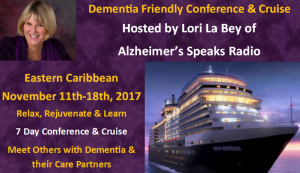 For an amazing way to widen your world, consider Lori’s upcoming November Dementia Friendly Conference and Cruise. Lori and a team of educators, including a panel of inspiring people who are living with dementia, have planned a nurturing, connecting, educational, and inspiring Caribbean trip. For more information, visit, https://alzheimersspeaks.com/cruise-with-us
For an amazing way to widen your world, consider Lori’s upcoming November Dementia Friendly Conference and Cruise. Lori and a team of educators, including a panel of inspiring people who are living with dementia, have planned a nurturing, connecting, educational, and inspiring Caribbean trip. For more information, visit, https://alzheimersspeaks.com/cruise-with-us
Deborah Shouse is the author of Connecting in the Land of Dementia: Creative Activities to Explore Together and Love in the Land of Dementia: Finding Hope in the Caregiver’s Journey.
Four Fine Ways to Keep Remembrances Blooming
How do you celebrate Mother’s Day or Father’s Day when your parents are no longer living? As the day approaches, I think of my parents and look for ways to keep remembrances blooming. During the years, I’ve explored ways to feel close with my mother, father, and other loved ones who have passed on. Here are four of the actions that keep me connected.
Dress to Connect
When I feel lonely for Mom, I like to put on her black blouse emblazoned with silver sequins. When Mom wore this blouse, it signified she was going someplace elegant. She accompanied it with a long black skirt and high heels. When I put on my ordinary black slacks and black tennis shoes, I imagine my mother shaking her head. “Don’t you have any better shoes, dear?” My mother prods me from beyond the grave, intoning, “A little lipstick would be nice.” Here’s the lovely part of our post-death ritual: instead of bristling at her grooming suggestions, I see how she wished the best for me and fondly remember her love of dressing up.
Feed your Memories
I still love to eat and share my parents’ favorite foods. My brother, who has untold culinary abilities, has mastered Mom’s butterscotch brownies and he has improved on her chocolate chip cookie recipe. He often bakes those for family gatherings and sometimes even mails me a box of nostalgic homemade treats. As for my dad, he particularly liked Planter’s Deluxe Nut Mix. He adored the cashews, but he didn’t want to spend the money to upgrade to all cashews. He preferred to pick out the deliciously rare morsels, leaving behind a plethora of peanuts, almonds, and hazelnuts. In his honor, I often buy a can of mixed nuts. Did you know that memorial cashews have no calories?
Tell their Stories
We all have heirloom family stories that anchor us in our history. My father liked to talk about his growing up days in the Canal Zone, in Colon, Panama. My mother favored her time serving as an Army nurse in Iceland during World War II. These were the stories of my growing up years and I think of them every time someone talks about Iceland, Panama, the Canal, or WWII. I have written some of them down so I won’t forget them. When I tell one of my parents’ stories, I feel they are in the room, leaning forward, smiling, and listening with delight. I like to share these tales at family gatherings and I like to tell them to friends. I also like to invite other people’s legendary stories.
Continue the Conversation
Sometimes I go on a solitary walk and talk to my mother. She loved birds and I point out the robins, cardinals, and sparrows on the route. I also tell her about my grandchildren, my work, and I discuss any dilemmas I’m struggling with. My father loved being in the water and I often commune with Dad when I’m swimming backstroke. I tell him entertaining things that are going on and talk to him about my dreams and big ideas. My parents are still good listeners and I picture them nodding proudly and cheering me on.
A version of this article originally appeared on MariaShriver.com
Deborah Shouse is the author of Connecting in the Land of Dementia: Creative Activities to Explore Together and Love in the Land of Dementia: Finding Hope in the Caregiver’s Journey.
Embracing Person-Centered Dementia Values: The Dementia Action Alliance
One by one, we say hello via video conferencing. We are writers, artists, and arts advocates from all over the country. One sculptor enriches the visual aspects of our meeting by strolling through a museum, giving us occasional glimpses of vibrant art. We meet another artist’s dog. Via video, we see each other’s offices and learn each other’s names and goals. Some of the participants are living with dementia; some are not. All of us are brainstorming ways to use the arts as a catalyst to connect people. Already it is working: through the Dementia Action Alliance, our arts group is already engaging in deep and honest conversation, discussing ways to weave creativity and the arts through June’s conference in Atlanta, and exploring ways we can help others stay connected through the arts.
I have long admired the Dementia Action Alliance and feel honored to be part of their creative process. Their “Person-Centered Dementia Values and Principles” were inspired by the Pioneer Network and have been customized by people living with dementia. Karen Love, Executive Director of DAA, tells us, “Because people who have dementia are the experts, the values are written from their perspective in first person narrative. This orientation helps us focus on what is important.”
Here are some of their core ideas:
Person-Centered Dementia Values and Principles
• I am a person living with dementia. Spend time getting to know me and relating to me as a person with a unique background, life history, interests and capabilities.
• Help me stay connected to what is important to me. Although aspects of my personhood may become increasingly hidden, I am still here.
• A reciprocal relationship is important to me. Autonomy, choices, dignity, privacy, self-determination are fundamental to my well-being.
• Support my holistic emotional, social, physical, cultural, sexual, and spiritual dimensions.
• Promote my personal growth and development. Help me continue to experience purpose, meaning, relationships and enjoyment in my daily life.
• Partner with me, utilize my strengths, and provide the right amount of support and opportunities I need to achieve my goals.
• Some dementia symptoms may interfere with my communication. I communicate the best I can; assume positive intent. Attempt to understand my needs and my reality. Please be compassionate.
For me, reading these principles reminds me how much we are all alike.
For more information on this topic and to learn about the DAA’s upcoming conference:
Conference: Re-Imagine Life with Dementia
You’ll enjoy reading this white paper on Living with Dementia: Changing the Status Quo, DAA
Deborah Shouse is the author of Connecting in the Land of Dementia: Creative Activities to Explore Together and Love in the Land of Dementia: Finding Hope in the Caregiver’s Journey.
Five Tips for Using Music to Connect
Even as a child, I was using music to connect with my parents. My father was a DJ and my mother enjoyed show tunes and old standards. Those songs often played on our record player and we all enjoyed listening. Later, I used that same music to connect me to my mom and dad during her dementia journey.
Today, I am thrilled to sharing the insights of Mary Sue Wilkinson, Founder of Singing Heart to Heart. Just reading her ideas makes me want to burst into song.
Meaningful Visits: 5 Tips for Using Music to Connect
By: Mary Sue Wilkinson, Founder of Singing Heart to Heart
Let’s face it. Visiting someone with Alzheimer’s or dementia can be hard. You want to connect. You want to make them happy. But things have changed. I understand. I’ve been there. I found a way to connect that I’d like to share with you. Let me explain.
My father in law Virgil had dementia and eventually lost all language. The only thing he could say was “gaba gaba.” His face would light up when I came to visit. I think he knew I was someone he loved. But after the first hug and shared smile…I would flounder. Carrying on a one sided conversation only went so far. I would leave feeling lonely and discouraged. I bet he felt the same. As much as I hate to admit it, I began to put off visiting him.
Virgil had been a Church of the Brethren minister. He knew and loved all the old southern gospel songs. One day I took my guitar and began to play and sing for him. I figured I could at least entertain him for an hour or so. I started singing an old favorite: I’ll Fly Away. Virgil lifted his head, broke into a huge smile and began to sing along. Every word. Perfect pitch. He even added harmony From then on music was the focus of our visits.
It didn’t cure Virgil’s dementia. He couldn’t carry on a conversation with me when the song ended. (Although I have seen this happen with others.) But we connected in a meaningful, joyful activity. This was something we could do together. I began to look forward to our visits. I had learned that we could be together without conversation.
Have you ever hesitated to visit someone with dementia or Alzheimer’s because you were afraid you wouldn’t know what to do or what to talk about? Do you feel like you are losing your connection to your loved one or friend?
Music was the “gift” that allowed me to have meaningful, connected, and happy visits with my father-in-law. I hope that it can do the same for you. Here are some suggestions to get you started.
5 tips for using music when you visit someone with dementia
1. When dementia has progressed to the point where conversations are difficult, or even impossible – turn to music. Singing together and/or listening to music can bring happiness regardless of skill or memory. Remember that you are seeking moments of joy and connection. A shared music experience may or may not elicit shared memories. What it will do, is give you a shared experience, in the moment.
2. Bring music with you to your visit – either holiday music or music popular when they were young. Plan ahead and then share it by saying, “I brought some music I thought we could enjoy together.” If the person you are visiting does not have a CD player in their room, bring one from home, borrow one from the activity director or consider purchasing one as a gift. (You can purchase or download my CD of well known songs here.)
3. If you don’t play recorded music, you can simply sing. Even singing one or two songs will lift spirits – for everyone. It’s a great way to establish a positive mood and communicate that you are someone “good.” Choose well known and simple songs such as You Are My Sunshine, My Bonny Lies Over the Ocean, or I’ve Been Working on the Railroad. Or choose well known holiday songs or songs of faith. These songs often evoke the strongest response from people, bringing a powerful connection. (You can download my free song guides here on my website.)
4. Involve your children or grandchildren in planning a musical visit. Give them the job of figuring out what was popular when your loved one was in their 20’s and 30’s and downloading that music to play during the visit. Let them use their smart phone to make a playlist. Do they have a wireless speaker they could bring along?
If your loved one asks for a song you don’t have ready, simply go to You Tube to find it.
5. Add some energy and fun to your musical time together by patting and clapping to the beat. Don’t hesitate to dance. You may be surprised. Sometimes people can dance better than they can walk. Standing or sitting you can still “dance” together and enjoy a sweet connection.
Remember: “When words fail, music speaks.” (Hans Christian Anderson)
 Mary Sue Wilkinson is the founder of Singing Heart to Heart where each year she leads close to 400 singing and music experiences for seniors. She specializes in using music in dementia care. Mary Sue is the author of “Songs You Know By Heart: A Simple Guide for Using Music in Dementia Care” which includes her recording of favorite sing alongs as well as a contribution from Teepa Snow. Learn more and contact Mary Sue at Singing Heart to Heart.com
Mary Sue Wilkinson is the founder of Singing Heart to Heart where each year she leads close to 400 singing and music experiences for seniors. She specializes in using music in dementia care. Mary Sue is the author of “Songs You Know By Heart: A Simple Guide for Using Music in Dementia Care” which includes her recording of favorite sing alongs as well as a contribution from Teepa Snow. Learn more and contact Mary Sue at Singing Heart to Heart.com
Deborah Shouse is the author of Connecting in the Land of Dementia: Creative Activities to Explore Together and Love in the Land of Dementia: Finding Hope in the Caregiver’s Journey.
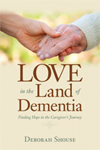

Connect through Movies and Memories
No one said, “Hush,” during the excitement of the paper airplane-flying competition in the Plaza Library. No one put a warning finger to his lips during the spontaneous conversations about favorite childhood foods. And laughing and clapping were encouraged during the two short films and two clips that anchored the Feb 11th Movies and Memory event, an invitation to connect through movies and memories. 
Most of the audience that poured into the Truman Forum that Saturday afternoon could not resist the alluring aroma of the freshly popping corn and stopped to get their free fix. They settled into the comfortable seats and sang along as music therapist and performer Rachelle Norman invited audience members to croon old favorites such as Blue Suede Shoes and Tennessee Waltz. Then they enjoyed two Oscar-nominated shorts, Paper Man and The Feast. 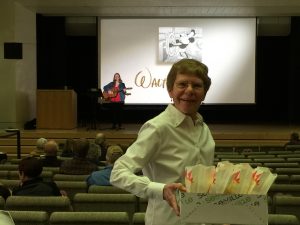
Everyone stood and walked through a waltz, guided by a ballroom dance instructor, after a romantic clip from Cinderella’s ballroom scene. After the final rousing cinematic scene, Marian the Librarian from The Music Man, everyone smiled as volunteers handed out cozy heart-shaped boxes of Russell Stover’s chocolates and shining red carnations. 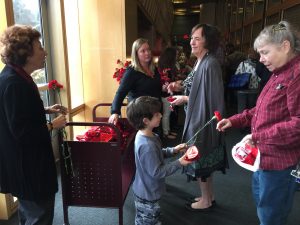
“What a great way to end the week,” one of the caregivers said.
Later, Michelle Niedens, Education Director at the Heart of America Chapter of Alzheimer’s Association, said, “I don’t know whether we have more fun planning these events or participating in the events.” All of us on the planning team agreed. This partnership with the Kansas City Public Library, the Alzheimer’s Association, the Kansas City FilmFest, and The Creativity Connectiong (me and Ron) is filling us all with hope and joy. Our quest to create a dementia and family friendly film series is happening and we are delighted. It’s free of charge, offering families a lovely way to have an uplifiting and interesting experience together.
Don’t miss our next event on April 9th, 1:30 at the Plaza Library. We are thrilled to be part of the Kansas City FilmFest. and we are planning some lovely surprises for our attendees. 
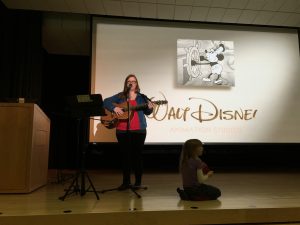
For additional information visit: www.kclibrary.org/signature-events/movies-and-memories-annie
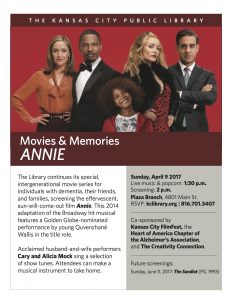
Finding Meaningful Memory Care
“I feel like I’ve been on extended vacation,” Ron’s father Frank said, after his first day in a memory care facility. “Today was really enjoyable.” Ron and I just melted with happiness. We had visited many facilities, with the hope of finding meaningful memory care with great activities. Frank couldn’t have said anything nicer.
It’s quite an emotional journey, finding meaningful memory care. I asked my friend, Dr. El, Dr. Eleanor Feldman Barbera, PhD, author of The Savvy Resident’s Guide and a columnist for McKnight’s Long Term Care News, for some tips.
Finding Meaningful Memory Care With Engaging Activities
“Remember, everything is an activity,” says Dr. El. She encourages care partners to seek a community with a dedicated memory care program, so people with cognitive impairments can benefit from all the offered activities.
“In a specialized unit, staff are trained to work with people who are living with dementia,” Dr. El says. “This training can help people enjoy greater independence.”
In one facility, a lady liked to wander into people’s rooms and take their jewelry. Rather than getting upset, the staff understood, framed this as “shopping,” and simply returned the jewelry.
“These kinds of insights create a calmer, slower-paced environment that reduces agitation,” says Dr. El.
Seek Structure, Soothing and Variety
Here are some things to look for, as you visit facilities:
- Is there a home-like atmosphere?
- Is there a structure to the day?
- Are there calming activities scheduled for change of shift? Changing shift is disruptive, so some communities orchestrate a teatime with music or other soothing activities.
You’re also making sure there are a variety of activities throughout the day. These should include:
Outdoor Time: Taking people outside makes a big difference in mood, appetite, and the sense of connection to the world.
Movement: Exercise is an important component to health.
Nurturing: Look for activities that make people feel confident and good about themselves, such as spa days or activities that incorporate skills such as cooking, art or gardening, modified to provide a “success” experience.
Engagement: Being engaged, rather than just entertained, inspires a sense of purpose, creativity, and social connection.
Kindness is Everything
“Meet with the recreational therapist,” Dr. El suggests. “Is she compassionate and caring? Are the staff members kind? You can have all the activities in the world but if they’re not done with gentleness and humanity, they won’t work.”
Let the recreation director know what your loved one likes to do and see if she can adapt the activity.
Stay Involved
Visit as often as you can and attend activities together. Encourage friends and relatives to join you. Meet other residents and get to know the families and staff.
“You can act as a connector to create friendships, so residents engage in their own interaction, even when you aren’t there,” Dr. El says.
For more information, visit Dr. Eleanor Feldman Barbera, PhD, http://www.eldercarewithdrel.com,
Treat yourself to Dr. El’s book, The Savvy Resident’s Guide



